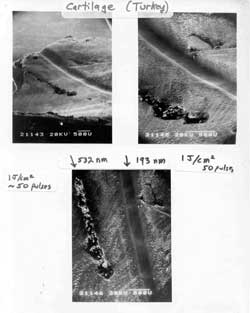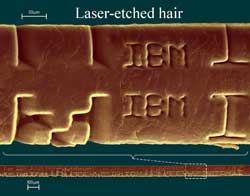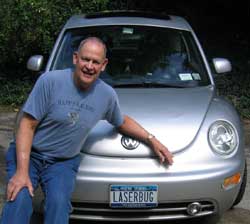James Wynne
After receiving his doctorate in applied physics from Harvard in 1969, James Wynne joined IBM Research in Zurich, Switzerland. In 1971, he returned to the United States to join a laser science group at the IBM T.J. Watson Research Center, where he was soon promoted to manager. Together with Rangaswamy "Sri" Srinivasan and Samuel Blum, members of his team, he discovered excimer laser surgery, the foundation of the present day laser refractive eye surgery techniques, known as LASIK (laser in situ keratomileusis) and PRK (photorefractive keratectomy).

The first two images show the same micrograph at different magnifications, and a third showing a micrograph taken with more of a "top-down" orientation of the sample. The smooth "groove" to the right was produced by irradiation with 50 pulses of light from a 193 nm argon fluoride excimer laser, delivering a fluence of 1 Joule/square centimeter/pulse. The burned, charred region to the left was produced by irradiation with 50 pulses of light from a 532 nm Q-switched, frequency-doubled, Nd:YAG laser, delivering a fluence of 1 Joule/square centimeter/pulse.View Larger

A composite of colorized electron micrographic images of a laser-etched human hair. View Larger

James Wynne sitting on the bumper of his trusty Volkswagen Beetle, "LASERBUG".
"We were a basic science group, not focused on any particular IBM technology or product development, but simply looking for new things those lasers would make possible," says Wynne.
Wynne and his group acquired an excimer laser, which had recently become commercially available, in 1979. The laser was installed in the lab of Peter Sorokin, and everyone in the group was encouraged to use it. "As far as I know, it was the first excimer laser anywhere in at IBM," says Wynne.
Excimer lasers are great sources of laser light in the ultraviolet, depending on which gas is used as a medium. By changing the laser's gas mixture and mirrors, it is possible to create different wavelengths of light with varying levels of power.
Using the excimer laser with ArF gas operating at 193 nm in the far ultraviolet, Sri and his assistant discovered that they could produce clean, etched patterns in polymers. A polymer is a group of chemically interconnected monomers, where smaller molecules individually bond to form long chains. As the months passed, Wynne and Sri engaged in casual "water cooler" talks in the hallways of IBM. "We wondered, if the excimer laser could so cleanly etch polymeric material, what would happen if we tried it on human or animal tissue?" says Wynne.
"Frankly, we were afraid of shining it on our own skin, so we talked about shining it on some different types animal tissue, some cooked meat, or maybe something else from the cafeteria," continues Wynne.
Sri and Samuel Blum decided to try shining the excimer laser on their fingernails. They discovered the laser created precise, etched patterns in keratin, the tough protein that makes up fingernails. Faced with the undesirable notion of removing their fingernails for examination under an electron microscope, the experiment ended.
"What really broke things open, after all the talk of what kind of tissue we would use, was that Sri brought his Thanksgiving turkey leftovers into the lab the day after Thanksgiving in 1981. He used the excimer laser at 193 nm to etch a pattern in whatever bone, cartilage, or meat was on the tissue sample," says Wynne.
The following week, Sri and Blum did a more careful irradiation on the leftover turkey cartilage from Sri's Thanksgiving dinner. They used 193 nm light from the excimer laser to make a clean excision into the cartilage; tissue was removed by a succession of short pulses from the laser. Peering through an optical microscope, they saw no burning, charring or other evidence of damage to the surrounding tissue.
"I remember looking at the sample, this piece of turkey cartilage glued to a glass side. It didn't look all that impressive. I said OK, let's see what happens when we use a "conventional" laser, a high powered pulsed visible laser. I decided to use a Q-switched frequency-doubled Nd:YAG laser that I had in my lab, which produced green light at 532 nm " says Wynne.
He irradiated the turkey cartilage sample with pulses of green laser light. Under the microscope, the area surrounding the excision looked charred and black as coal. "I had this moment of eureka, we have a new form of surgery! By using the ultraviolet light of the excimer laser, we were getting an extremely clean cut, with no evidence of damage to the surrounding tissue," says Wynne.
Srinivasan, Blum, and Wynne had many brainstorming sessions about how this "clean excision" could be used for brain surgery, dentistry, orthopedics, and dermatology. Ironically, eye surgery was not one of the applications the three scientists pictured. Ophthalmologists had already been using a bright light source to treat retinal injuries. Eventually they replaced their light source with a ruby laser. The first recorded use of lasers in surgery occurred in December of 1961, to eradicate a retinal tumor on a patient, and laser-based retinal photocoagulation quickly became a common procedure.
Sri, Wynne and Blum wrote up and signed an invention disclosure at the end of 1981, and their patent application was filed in December of 1982. "During that year [1982], Sri and I got up the courage to use the 193 nm excimer laser on our own skin. I held up my pinky and shined the laser directly on it," says Wynne. "Each pulse of the laser ablated a thin layer of my tissue, yet there was no sensation of heat or pain. The tissue flying away from the finger exerted a backward pressure, and I felt that pressure, the puff," explains Wynne.
Wynne began collaboration with dermatologists from New York University Medical Center, and published several papers on the effects of the excimer laser on guinea pig skin, including healing studies. Sri, assisted by Bodil Braren, collaborated with ophthalmologist Steven Trokel, and performed an experiment where they irradiated the cornea of enucleated cow's eyes (from slaughter) using the excimer laser, producing clean incisions with no evidence of collateral damage.
Srinivasan, Braren, and Trokel published a paper on the laser etching of cow cornea in December, 1983 in a major ophthalmology journal. That paper inspired the ophthalmologic community to develop the procedures we know as LASIK and PRK, where the excimer laser is used as a sculpting tool to correct myopia, astigmatism, or hyperopia, by reshaping the front of the cornea. The first successful operation on a sighted human patient occurred in 1987, and since then over 20 million people have had these laser refractive surgical procedures.
Wynne believes that the future of laser eye surgery holds much promise, not only for correcting impaired vision but for allowing "superhuman" vision, i.e., better than 20/20, and for enabling people to hold jobs that require precise vision, such as military piloting. In his opinion, these types of alterations will become common.
James Wynne is the author of numerous articles and scientific journals and the holder of many patents, including several in laser dentistry and laser dermatology, and has received numerous Outstanding Innovation Awards throughout his career at IBM. In 2002, James Wynne, along with Rangaswamy Srinivasan and Samuel Blum were inducted into the National Inventors Hall of Fame. In 2010, they will share the Rank Prize in Optoelectronics with ophthalmologists Steven Trokel and Francis L'Esperance.











